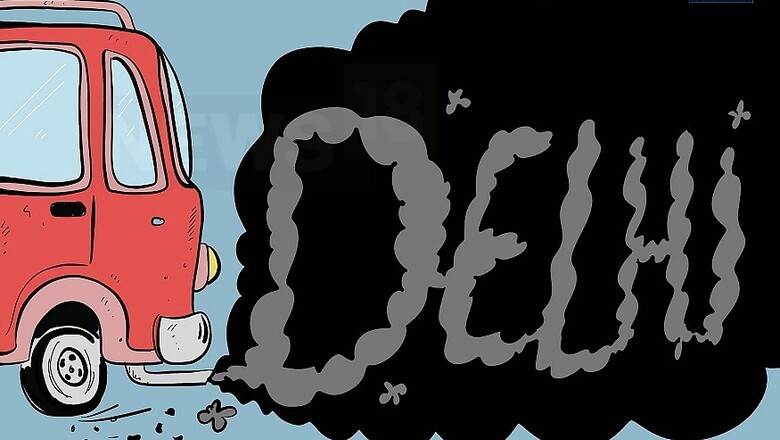
views
In 2018, as per Greenpeace rankings, Delhi, Gurugram and Noida together were ranked as the most polluted regions of the world. But for the Supreme Court of India, it would have been worse. Since 1985, in response to a writ petition filed by M.C. Mehta, the Supreme Court has adopted a quasi-executive role to directly make, manage and execute environmental regulation and policies, particularly those related to air control regulation in the National Capital Territory (NCT) of Delhi.
The Supreme Court has maintained a constant vigil on NCT’s air pollution levels, including directing the Government to institute automotive emission standards in 2000 - Bharat Stage Standards (BS Standards). Over the past two decades, through the Apex Court’s supervision, the BS Standards have been timely updated and implemented. The Supreme Court, in the long-standing litigation of M.C Mehta v. Union of India, has enforced April 01, 2020 as the deadline for all vehicle manufacturers to comply with BS-VI standards.
The Supreme Court has adopted a hand-on approach, as opposed to limiting itself to a policy. In December 1997, the Apex Court identified auto-rickshaws as major air pollutants and directed that the number of auto-rickshaws plying on the roads of NCT be frozen at their current levels and that no further permits be issued. Over the years, the Apex Court on the basis of the recommendations of the Environment Pollution (Prevention and Control) Authority (EPCA) and the Department of Transport regulates the number of auto-rickshaw permits issued for NCT.
Recently, a major auto-rickshaw manufacturer has moved the Supreme Court to either clarify that its limitation on the number of permits was for three-wheelers that were using non-clean energy fuels, or alternatively, to lift the ban on permits altogether. This manufacturer also informed the Court of its preparedness to introduce auto-rickshaws compliant with the BS-VI standard, a year ahead of the official April 2020 deadline. While such news should be positive because BS-VI compliant vehicles are much more efficient than the current BS-IV compliant vehicles, however, this move could create a market anomaly and destabilize the entire automotive industry which is already hard-pressed to meet the April 2020 BS-VI deadline.
If indeed the Apex Court, ahead of its self-adjudicated April 2020 deadline, were to lift ban on permits for BS-VI compliant autos, while still applying the permit system to BS-IV compliant vehicles, the Court could effectively create a monopoly player well before the deadline of April 2020. On the other hand, the Supreme Court’s allowing the writ will result in immediate environmental benefits but this would come at the cost of compromising market competition – granting a virtual monopoly to a single player.
Another dimension to opening up of permits is the traffic congestion caused by the flood of autorickshaws on the already chocked NCR roads. It is learnt that the Ministry of Road Transport and Highways is in favour of granting new permits (without cap) only to electric autorickshaws. The impact of such decisions on traffic congestion as well as on morale of the automotive industry which is busy manufacturing BSVI compliant Diesel-Petrol-CNG-LPG autorickshaws needs to be ascertained holistically by the Supreme Court.
Do questions on market competition matter when Courts are deciding environmental matters, or any subject seemingly unrelated to the state of competition in the market? The question begs a larger debate on the relationship of competition or economic laws with policies aimed at Sustainable growth and development. Competition law, as an economic law is aimed at supplementing governmental policies to achieve higher innovation, growth and sustainable economic development. The current case before the Supreme Court forces us to realize how real-world functions and the imminent important of addressing this policy debate.
Immediately, one might suggest that it is a no-brainer that the environment and health of citizens comes first. But the issue is more complicated than that. Sound economic policies require certainty around which companies can organize themselves. In this case, the Supreme Court itself set a target date of April 2020 for compliance with BS-VI emission standards, but there was no warning that it would become a race! How fair is it to change the rules of the game, the conditions of competition mid-way, even when it favours a non-economic agenda of the government, especially when the market operates on a permit-quota system?
It is essential to understand that there should ideally not be one winner in this debate, but the focus should be on finding the right balance in regulatory and judicial rule-making. While the discussion has until now been mostly academic, the implications could be very real. And it goes much beyond the current Supreme Court litigation.
India does not have a formal “regulatory audit” mechanism to carefully assess the costs and benefits of regulations across sectors or industries. For example, the “Better Regulation Executive” is a department of the Government of United Kingdom, which measures the regulatory burdens of new regulations/policies across sectors to ensure that regulations are smarter, targeted and less disruptive to businesses.
The “Office of Management and Budget” does the same work for the United States. In India, we definitely need an institutional framework to assess if environmental policies could disrupt businesses or if certain business policies could disrupt labour welfare; and how to achieve an amicable trade-off to such seemingly counter-intuitive objectives of policies or legislations. Our Courts should also be more open to internalize a judicial vision which attempts to balance positive and negative regulatory burdens across environmental, competition, health agendas of the Indian state.
It will be interesting to consider whether the Apex Court would rule any differently if it also considered the question of long term impact on the competitive landscape. Would this also be a fit case for consideration of the Competition Commission of India’s advisory jurisdiction with a reference from the Supreme Court allowing the Supreme Court to consider or at least, be mindful of the complete consequences of its decision? After all, it is not just the intended consequences of decisions that impact society but the unintended ones as well.
(The Author is a Associate Professor of Competition Law and Policy at the Jindal Global Law School. The views, thoughts, and opinions expressed in the text belong solely to the author)



















Comments
0 comment